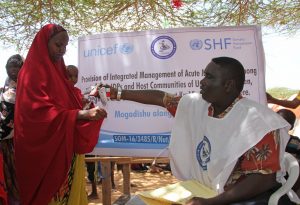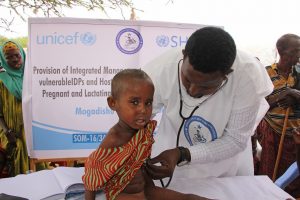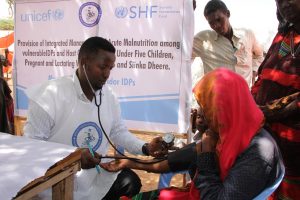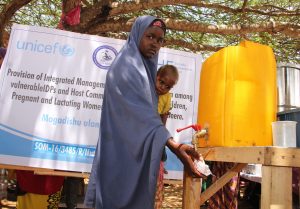 SOYDA has been actively providing OTP treatment through static and mobile/outreach services to enable reach the vulnerable population in Afgooye district. Through its nutrition intervention the organization was able to do community screening, referral, therapeutic treatment as well as IYCF and NHHP.
SOYDA has been actively providing OTP treatment through static and mobile/outreach services to enable reach the vulnerable population in Afgooye district. Through its nutrition intervention the organization was able to do community screening, referral, therapeutic treatment as well as IYCF and NHHP.
SOYDA is however, is scaling up the drought response to the displaced persons from other neighboring regions and already reached nearly 12,549 people with improved access to outpatient therapeutic program (OTP) and Emergency primary healthcare, doubling its response from January. Further scale-up is urgently required across all sectors. Priorities include treatment and prevention of AWD/Cholera, improved access to food and safe water, nutritional treatment for malnourished children, protection, shelter and non-food support to newly displaced person arriving at KM 13, Km15, Siinkadheer, Arbis, Lafole, Elasha and Horsed, Halgan and Kordamac IDPs in Daynile District, Benadir Region
More significantly, the organization is on top of the intervention where it gives high case managents at facilities in KM 13, Km15, Siinkadheer, Arbis, Lafole, Elasha and Horsed, Halgan and Kordamac IDPs in Daynile District, Benadir Region. This is through the funding from UNICEF, CHF and DFID and has realy facilitated the the response to the vulnerable population. Since the beginning of the year SOYDA have noted significant influence on child nutrition of particular concern are feeding practices (such as the low rates of exclusive breast-feeding in the first 3 months and the low frequency of active feeding of infants) and inadequate hygiene practices relating to food preparation. However, girls are at risk of highly malnourished and women generally shows poor understanding of their children nutrition status as well as the hygiene. Although most of the cases received were treated with improved and quality therapeutic and promotive services nevertheless there is high cases of children who are severely malnourished. The high prevalence of low birth weight (12.5%) remains a public health problem and reflects the poor nutritional status of mothers. The additional burden that can be placed on caregivers because of deaths within the family or as they themselves become sick, places the household at even greater risk of not being able to obtain and prepare food in appropriate hygienic conditions.
Through the community therapeutic feeding program SOYDA team have notice poor appetite among the severely malnourished children in some of the center, this was later established that most of the mothers don’t encourage their malnourished children to continuously take the plumby nut hence with poor health status children were still malnourished. However, SOYDA nutrition supervisor have taken step further to ensure appetite test are done at the center and establish children status for further response and referrals. Below is figure I art of such activities at KM 13.
Due to the decreasing access to and availability of food, combined with existing poor livelihood practices, active feeding and hygiene (especially for young children) there is a severe threat of an increase in malnutrition in the drought-affected fleeing families. The levels of micro-nutrient deficiency are also on the raise, impacting in particular upon lactating and pregnant women and children under five.
Most of the communities fleeing from far end Bay, Bakol and Lower Juba region where there were been controlled by AS which has suffered a lot in terms of immunization services, this has led low immunity to the children under the age of 5 years, however, these communities were forced to migrates from their original land due to the devastating drought and since they have not been immunized there were very susceptible to any kind of disease.
The current health aggravating factors are diarrhoea acute respiratory infections and measles. Most of the newly arrivals of internally displaced persons have high number of children under five having diarrhoea and hence these have also have an adverse effects. The incidence of diarrhoeal diseases usually increases during a drought. This is exacerbated by a reduced access to clean drinking water, to sufficient water for personal and household hygiene, and to existing poor sanitation practices. Cholera is endemic in Somalia and therefore the likelihood of an outbreak can be considered as high.
Due to the high number of people moving from hardly hits drought areas to Afgooye corridors where SOYDA is running health and Nutrition program specifically in Elasha, KM 13 and Lafoole areas which has been overwhelmed by the high number of people with poor health and nutrition status, the organization has been responding to the needs with a life-saving nutrition and health services.
The community is in dire needs of improved access to preventative and curative health services, such as health education, access to safe water and sanitation, and access to and availability of adequate food.
As of this reporting period SOYDA areas of operation have showed reduced access to sufficient water for personal and household hygiene that can lead to escalation in the number of cases of infections relating to cleanliness. Skin irritations and conjunctivitis are the most common of these, and previous experience shows that this is likely to become a significant issue.
Since the beginning of January to March 2017 Somali young doctors association have been actively providing emergency primary health care services through facility based and mobile clinics in KM KM 13, Km15, Siinkadheer, Arbis, Lafole, Elasha and Horsed, Halgan and Kordamac IDPs in Daynile District, Benadir Region. Towards this, SOYDA organization with the support of UNICEF, DFID and SHF provided support and continued provision of lifesaving health services in the stated areas. SOYDA has since continue providing life-saving emergency healthcare it its three health centers and four outreach services to increasingly gain access to primary healthcare services through facility based health services and deployment of four mobile health outreach teams who will visit villages on daily bases providing both curative and health promotion activities to a target population of 67,890.
Since January to March 2017 the following were some of the achievements:
- The number and proportion of pregnant women receiving at least four focused ANC visits was increased 10% to 35% and those of at two ANC visits to 50%. Similarly 1650 pregnant and lactating women were reach with an improved PNC in the target health center.
- 21,040 number of crisis affected women, children and Men in emergency was reached with improved life-saving primary health care services
- The number of eligible PLW receiving multiple micro nutrient (MMN) during the antenatal/postnatal period was increased to 45% ensuring that more sought services at the facilities institutional delivery.
- 62 women were assisted with skilled delivery at the SOYDA health facilities at Elasha Health Centre ensuring lives were saved.
- The number of children U-5 treated for acute diarrhoea in health facilities was increased by 15% ensuring timely response and saving lives of the internally displaced person.
- Over 10 at-risk pregnant women were referred to Banadir referral Health Centres and Hospitals.
- Health education and promotion has ensured that 40% mothers who have attended the facilities know how to treat diarrhoea at home using ORS.
- Support health centres in training, supplies and supervision
- Provision of supplies and materials to the beneficiaries.
Through this SOYDA was able to provide improved safe motherhood as well as treatment of common childhood illness hence this has ensured <5 children boys, girls and pregnant and lactating women to get easy and accessible services within the SOYDA operation sites.
SOYDA has also been focal in delivering healthy messages to the target population where mothers are considering the first level health education target group. This was aimed at improving mother’s health seeking behaviour as well as improving their understanding on diarrhoeal treatment at home with ORS.
Access to safe water and the practice of safe hygiene behaviours is a major contributing factor to health and development. Lack of these has a negative impact of the health and nutritional status of a population, and subsequently on education levels and capacities for productive work.
In relation to IDPs sanitation, very little is known regarding access to improved sanitation facilities. Inappropriate household excreta disposal, and personal hygiene practices contribute considerably to unhygienic conditions which exist close to communities, creating a breeding ground for disease and the possibility of diarrhoea, dysentery, and cholera. Repeated diarrhoea is a major cause of malnutrition and underweight, leading to susceptibility to other illnesses.
Gender disparities do exist in almost all the IDPs whereas Women take major responsibility for collection of water and for childcare at household level, perform a key role in water and sanitation and are potentially significant agents of change. Since access to water reduced, populations have been forced to travel greater distances to find water, and available sources hence this led to significant pressure among the displaced rural population who rely on insecure water sources and are already experiencing some difficulties in particular in parts of KM 13 and Arbis.
The problems described above are likely to impact on the amount of water available within the IDPs household for personal and household hygiene. The consequences of this will be seen in an increase in the cases of diarrhoeal diseases, and higher rates of skin and eye infections. This in turn will negatively impact on the health status and coping mechanisms of the members of the household.
Challenges and gaps in the target areas.
Despite the relative peaceful environment in Afgooye the target areas there were other challenges that in one way or the other hindered full realization of the project impacts as of reporting period, this includes:
- The long dry spell across the country and rural displacement to the urban, hence Afgooye corridors was not left behind and have had the highest burden in the worst drought affected areas in Lowe/Middle and Banadir region hence increased the number of beneficiaries against the planned.
- Continuous displacement from Shebelle’s rural pastoral livelihood who lost their animal due to drought led to move to the IDPs centers in KM 13 and Afgooye corridors hence this has overstretched the little resources available. However urgent scale up required in order to respond adequate to the raising needs of the IDPs and host communities and in order to support
- Poor sanitation and limited safe drinking water in the IDPs camps and the newly arrivals camp has also led to high AWD/cholera cases which has also caused death.
- Lack of previous immunization services among the displaced population from the areas of Al shabab controlled regions have led poor immune and susceptible to any kind of illness, Immunization as such important core activity in the program needs to be emphasized and community educated on the same though due to the poor immunization led to loss of life among the children who could not withstand with malnutrition cases.
- Poor protection services in the area led to reported cases of rape among the girls and women in IDPs and these who are trekking to get the lifesaving humanitarian services in KM 13.This has been on the raise in most part of the IDPs
- Poor livelihood alternatives that could have otherwise improved the live of the displaced vulnerable children and mothers led to poor food security in all the IDPs.
- High cost of water led to many household to trekked long distance to find the commodities, this was coupled with poor sanitation services in the IDPs camps hence increased AWD/cholera outbreak in most of the IDPs.
Proposed way forward.
To elevate the above anomalies there is a need to provide the following to the vulnerable IDPs and host communities affected by the drought and are in emergency that is:
- Scale up the integrated nutrition intervention through increasing the mobile OTPs and TSFPs to enable reach more vulnerable. This will be able to reach the far location that have hardly hit by the drought.
- Urgent water voucher services required to enable reduced the AWD/cholera cases among the vulnerable IDPs and host communities in KM 13, Elasha and Lafole project sites. This will be able to integrate with the current nutrition and health services and will provide more integrated services to the communities hence reducing the occurrence of AWD/cholera cases in KM 13, Km15, Siinkadheer, Elasha and Lafole SOYDA project areas.
- Urgent initiation of livelihood program that would be able to provide an alternative means for the family food security hence this will go a long way in improving the nutrition and health status of the displaced drought affected community members.
- Psychosocial support and clinical rape management centers require. SOYDA is currently providing case management at the facility based but this could not cater the increased cases as well as continuous displacement of the population hence required more scale up and establishment of the GBV clinic for counseling of the rape cases and as well to provide dignity kits to the vulnerable girls in the IDPs. This will be able to provide protection to the poorly shelter house hold in the program location. The continuous suffering of women and girls under the hands of the devastating situation will have both social impact as well as health status of the IDPs and host communities displaced by the drought.
- Immunization campaign should be initiated to enable provide mass immunization campaign and reach higher number of children who have never had the opportunity













